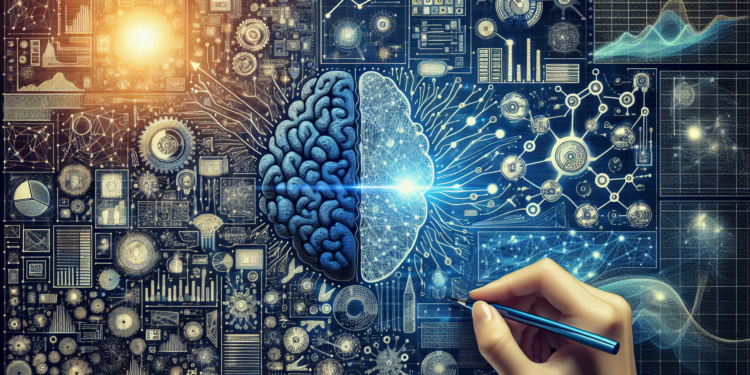Deep Learning has reshaped our understanding and application of artificial intelligence (AI), facilitating unprecedented advancements in natural language processing, computer vision, and more recently, in generative modeling. In this comprehensive analysis, we explore the fundamental theories of deep learning, recent advancements in neural network algorithms and architectures, and emerging practical applications, while projecting into the future of the field.
Fundamental Theories of Deep Learning
Deep learning is a subfield of machine learning (ML) that employs multi-layered neural networks to discover high-level data representations. These representations are learned hierarchically, where low-level features are transformed into more complex abstractions.
Key Algorithms
Backpropagation
First introduced in the 1980s, the backpropagation algorithm remains a cornerstone in neural network training. It optimizes the cost function by adjusting weights and biases in the network through a computation of descending gradients.
Stochastic Gradient Descent (SGD)
A critical variant of this algorithm is stochastic gradient descent and its adaptations (Adam, RMSprop), which enhance efficiency and allow for rapid convergence when minimizing cost functions over batches of data.
Advances in Neural Network Architectures
Convolutional Neural Networks (CNNs)
CNNs are fundamental in computer vision. They excel due to their ability to detect local and translation-invariant features, utilized in image detection and classification. The integration of attention modules has significantly improved their performance.
Recurrent Neural Networks (RNNs) and Long Short-Term Memory (LSTM)
RNNs, and particularly LSTMs, excel in processing sequences such as natural language or time series, thanks to their capability to retain relevant prior information and mitigate the vanishing gradient problem.
Transformers
More recently, the Transformer architecture has revolutionized natural language processing. Its self-induced attention mechanism facilitates the modeling of long-range dependencies and has laid the foundation for models such as BERT and GPT-3.
Optimization and Regularization
With the advent of increasingly deep and complex architectures, optimization has taken on a vital role. Techniques such as batch normalization and dropout regularization are indispensable in dealing with overfitting and ensuring model generalization.
Recent Advancements and State-of-the-Art
The frontier of knowledge in deep learning continues to expand. Advancements in terms of computational efficiency, explainability, and transfer learning reflect the maturity and versatility of the field.
Computational Efficiency: Efficient Neural Networks
The creation of more efficient models, like MobileNets and EfficientNets, enables the deployment of deep learning on mobile and edge devices with resource constraints.
Explainability: XAI
Explainable Artificial Intelligence (XAI) seeks to unravel the “black box” of neural networks, providing visibility into the model’s decision-making process and increasing trust in its predictions.
Transfer Learning: Pre-training and Fine-tuning
Pre-training models on large datasets followed by task-specific fine-tuning has proven effective, positioning models that require less data for optimal performance in specific tasks.
Emerging Practical Applications
Deep learning has been incorporated into multiple spheres of human activity, producing significant transformations in industries and services.
Health: Assisted Medical Diagnosis
Neural networks, particularly CNNs, are used to diagnose diseases from medical images, often with accuracy that surpasses that of a human expert.
Enhanced Creativity: Generative Systems
Generative Adversarial Networks (GANs) and Transformer architectures are being used to create innovative art, music, and literature, raising philosophical questions about the nature of creativity.
Robotics: Deep Reinforcement Learning
The integration of deep learning with reinforcement learning has achieved notable accomplishments in robotics, enabling robots to learn complex manipulation and navigation tasks autonomously.
Current Challenges and Future Directions
Deep learning is not without its challenges, including the need for large amounts of labeled data, vulnerability to adversarial examples, and high computational costs. These limitations present opportunities for innovation.
Reduced Data Dependency
Research towards more data-efficient deep learning is underway, including semi-supervised learning and few-shot learning.
Resistance to Adversarial Attacks
Robust techniques are being developed to increase the security of models against malicious attacks designed to deceive neural networks.
Sustainable Computing
The pursuit of more sustainable deep learning models is intensifying, advocating for energy-efficient algorithms and specialized AI hardware.
Conclusion
Deep learning continues to be a vibrant area of artificial intelligence, promising significant breakthroughs across multiple domains. The ongoing innovation in algorithms, architectures, and practical applications is a testament to its resilience and potential to transform how we interact with technology. With an eye on sustainability, security, and efficiency, deep learning is poised to tackle future challenges by offering solutions that were previously beyond human ingenuity.






















